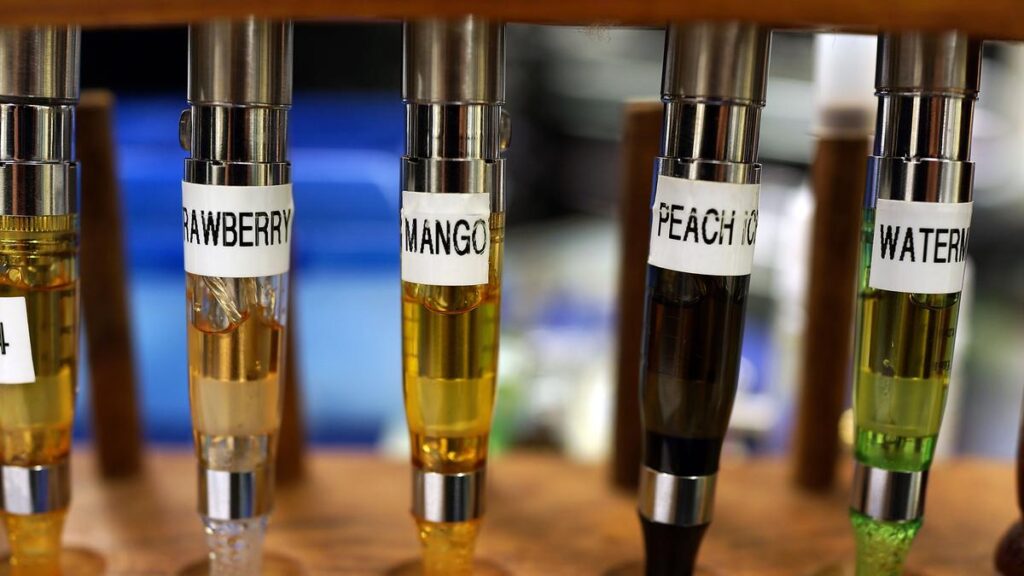
Vaping can cause inflammation (swelling) and irritation of the lungs leading to scarring and narrowing of the tubes that bring air in and out of the lungs. Photograph used for representational purposes only
| Photo Credit: AFP
India is one of the few countries that has completely banned the sale of e-cigarettes to protect young people from e-cigarette-related harms. This is especially notable given that India has a young population, with 65 % of people in the country being below the age of 35 years. Around 27 % of the Indian population uses tobacco in some or other form (World Health Organization, 2017).
The misconception that e-cigarettes are an effective tool to quit smoking might stir controversy, especially as vaping is being promoted as less harmful than smoking, and vaping products come in the most popular flavours (tobacco, mint, and chocolate). Its users are often well-educated and come from privileged backgrounds, allowing them the financial means to afford vaping. Many also seek to align with vaping communities on social media, where they can connect with peers and showcase their lifestyle.

E-Cigarette ban in India
The Indian government, in 2019, enacted the Prohibition of Electronic Cigarettes (Production, Manufacture, Import, Export, Transport, Sale, Distribution, Storage, and Advertisement) Act to protect public health and banned the production, sale, and advertisement of electronic cigarettes.
The Act, which came into effect on September 18, 2019, aims to curb growing concerns about the harmful effects of electronic cigarettes and similar devices. Under the law, no individual or entity is allowed to produce, manufacture, import, export, transport, sell, or distribute electronic cigarettes. This includes both the complete product and its parts.

Vapes compared to smoking in terms of nicotine
Generally, a smoker absorbs between 1 milligram and 2 mg of nicotine from a single cigarette. Although there is between 8 mg and 20 mg of nicotine, only a fraction is inhaled – generally thought to be about a tenth. Various factors alter this – the strength of the filter, each person, and how much is lost in the smoke – but this amount is a general rule of thumb. Regular cigarettes lead to the inhalation of about 1.2 mg of nicotine per cigarette or 24 mg of nicotine per 20 pack.
Most popular vapes that are illegally sold in India come in nicotine strengths of 10 mg/ml, 20 mg/ml, and 40mg/ml, so a 2 ml vape typically contains 10 mg to 40 mg of nicotine and allows for between 600 and 800 puffs.
A 20 mg/ml vape, with 40 mg of nicotine, is therefore the equivalent of smoking one or two packs of 20 cigarettes. This shows the addictive and harmful nature of vapes
Isn’t vaping just water vapour? — No. Despite the name, vaping doesn’t make water vapour. It actually creates an aerosol (or mist) that contains small particles of nicotine, metal and other harmful substances.
What is in the e-liquid (e-juice)? — E-liquid, also called e-juice or vape juice, usually contains flavoring to mask the harshness of nicotine. Nicotine is the addictive and harmful substance in cigarettes and other tobacco products. It also contains propylene glycol and glycerin, to create vapor.
What is the effect of vaping on the lungs?
Vaping can cause inflammation (swelling) and irritation of the lungs leading to scarring and narrowing of the tubes that bring air in and out of the lungs. Vaping leads to EVALI (e-cigarette, or vaping, product use-associated lung injury). EVALI is a serious lung condition that vaping causes. It causes widespread damage to the lungs and lead to symptoms like coughing, shortness of breath and chest pain. EVALI can be fatal.

Quit smoking without vape
Vaping isn’t approved as a way to quit smoking. Approved methods include patches, inhalers, lozenges, and gum. Tobacco cessation clinics and National Tobacco Quit Line Services (NTQLS) – 1800 112 356 can guide people on the proper ways to quit smoking.
(Dr. Priyamvada Sharma is an associate professor ,Department of Clinical Psychopharmacology and Neurotoxicology , NIMHANS, Bangalore, [email protected]. Prof. Pratima Murthy is director and senior professor of psychiatry, National Institute of Mental Health and Neurosciences (NIMHANS), Bangalore, [email protected])
Published – March 28, 2025 04:30 pm IST

